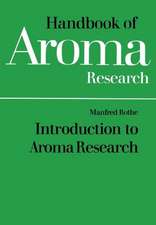Risk Assessment Methods for Biological and Chemical Hazards in Food
Editat de Fernando Pérez-Rodríguezen Limba Engleză Paperback – apr 2022
Risk Assessment Methods for Biological and Chemical Hazards in Food introduces the reader to quantitative risk assessment methods encompassing general concepts to specific applications to biological and chemical hazards in foods. In the first section, the book presents food risk assessment as methodology and addresses, more specifically, new trends and approaches such as the development of risk rating methods, risk metrics, risk-benefit assessment studies and quality assessment methods.
Section II is dedicated to biological hazards. This section identifies the most relevant biological hazards along the food chain and provides an overview on the types of predictive microbiology models used to describe the microbial response along the food chain. Chapter 12 specifically deals with cross contamination and the quantitative methods that can be applied to describe this relevant microbial process. The development and application of dose-response models (i.e. mathematical function describing the relationship between pathogen dose and health response) are also covered in this section. In Section III, the book translates risk assessment concepts into the area of chemical hazards, defining the process steps to determine chemical risk and describing the uncertainty and variability sources associated with chemicals.
Key Features:
- Presents new trends and approaches in the field of risk assessment in foods
- Risk assessment concepts are illustrated by practical examples in the food sector
- Discusses how quantitative information and models are integrated in a quantitative risk asssment framework
- Provides examples of applications of quantitative chemical risk assessment in risk management
| Toate formatele și edițiile | Preț | Express |
|---|---|---|
| Paperback (1) | 579.25 lei 6-8 săpt. | |
| CRC Press – apr 2022 | 579.25 lei 6-8 săpt. | |
| Hardback (1) | 1290.19 lei 6-8 săpt. | |
| CRC Press – 29 oct 2020 | 1290.19 lei 6-8 săpt. |
Preț: 579.25 lei
Preț vechi: 681.47 lei
-15% Nou
Puncte Express: 869
Preț estimativ în valută:
110.87€ • 120.47$ • 93.19£
110.87€ • 120.47$ • 93.19£
Carte tipărită la comandă
Livrare economică 21 aprilie-05 mai
Preluare comenzi: 021 569.72.76
Specificații
ISBN-13: 9780367523589
ISBN-10: 0367523582
Pagini: 545
Ilustrații: 75
Dimensiuni: 156 x 234 x 28 mm
Greutate: 0.76 kg
Ediția:1
Editura: CRC Press
Colecția CRC Press
ISBN-10: 0367523582
Pagini: 545
Ilustrații: 75
Dimensiuni: 156 x 234 x 28 mm
Greutate: 0.76 kg
Ediția:1
Editura: CRC Press
Colecția CRC Press
Public țintă
Professional ReferenceCuprins
General Aspects. Food Risk Assessment Framework: Foundations and Concepts. Quantitative Methods for Risk Assessment. Metrics for Risk: Evaluating the Impact of Illness and Disability on Public Health. Risk-benefit Assessment in Foods. Application to Quantitative Risk Assessment Methods for Food Quality. Understanding Uncertainty and Variability in Risk Assessment. Application of Sensitivity Analysis Methods in Quantitative Risk Assessment. Microbial Risk Assessment. Quantitative Methods for microbial Risk Assessment in Foods. Hazard Identification: Emerging and New Microbial Risks Along the Food Chain. Predictive Microbiology Tools for Exposure Assessment. Modeling Cross Contamination and Hand Handler Behavior. Expert Systems Applied to Microbial Food Safety. Dose Response Models for Foodborne Microbial Risk. Uncertainty Analysis in Chemical Risk Assessment. Quantitative Chemical Risk Assessment Methods. How to Cope with censored Data in Chemical Risk Assessment. Use of “Toxigenomic Tools” in Chemical Risk Assessment: Present and Future Perspectives. Examples of Quantitative Chemical Risk Assessments: Use and Application in Risk Management. Nutritional and Food Allergen Risk Assessment: Methods and Future Perspective. Future Applications of Risk Assessments and Concluding Remarks.
Descriere
As a result of the recent international agreements on the use of Risk Analysis framework, international organization and governments have adopted risk assessment as a science-based process to ensure food safety in the food chain. This book introduces risk assessment methods considering both general aspects and specific ones to the type of hazard, that is, biological and chemical hazards. In addition, specific sections are intended to show more technical details on key elements of risk assessment such as separation of uncertainty and variability or application of sensitivity analysis. Specific examples are given to show readers how risk assessment techniques can be applied in practice.
























